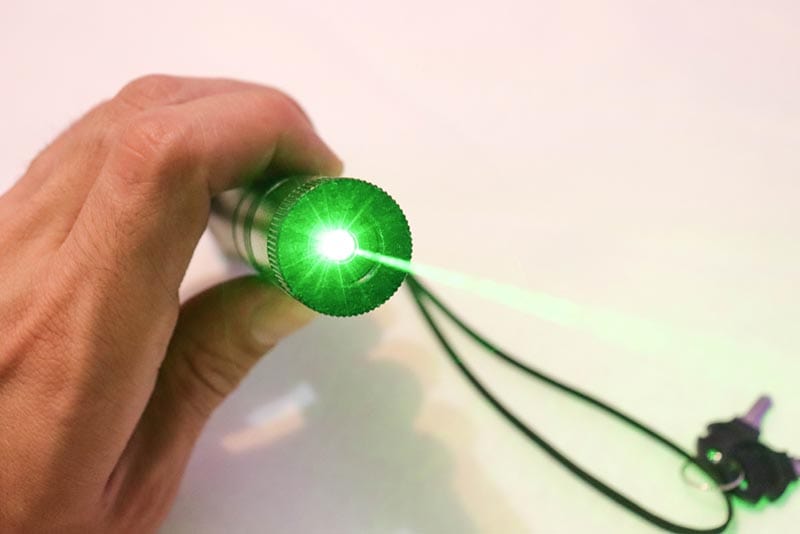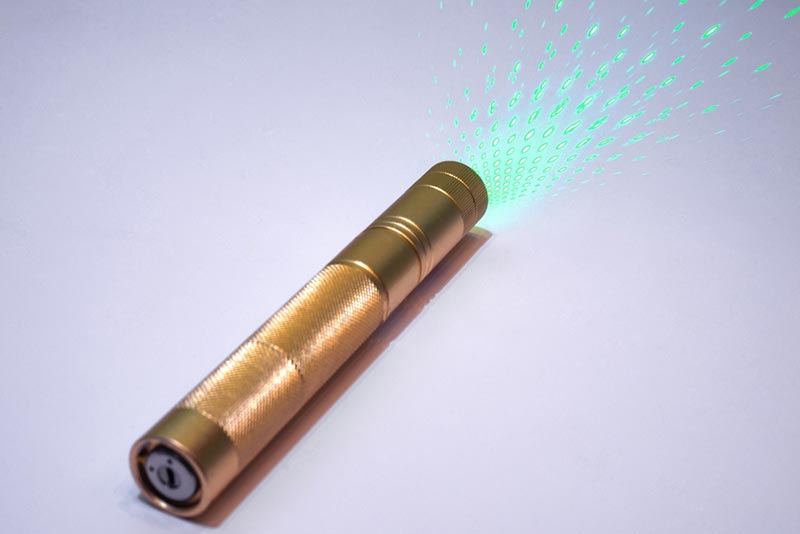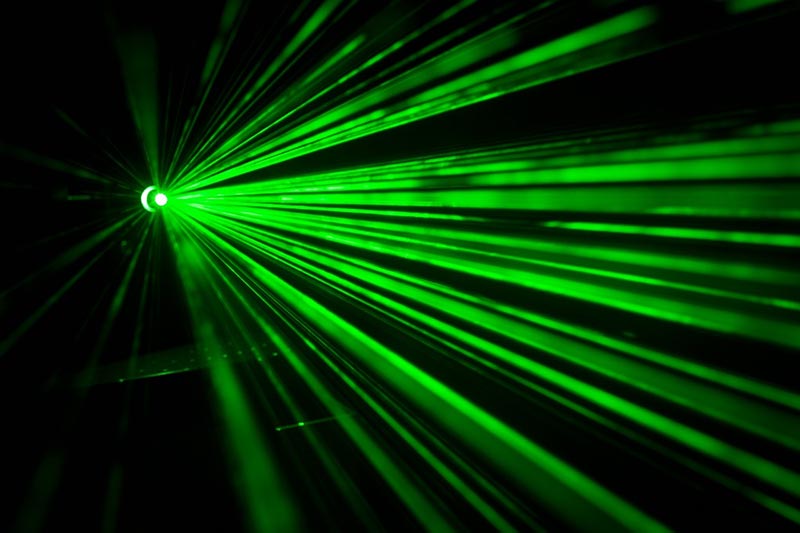Are Green Lasers Illegal? The Surprising Answer!
Last Updated on

We don’t know much about the rules and regulations in other countries, but in the U.S., there is nothing illegal about owning a laser.
This whole confusion came about when dubious sellers and manufacturers started producing lasers that were more than 5 milliwatts, then called them pointers. That implied that these types of lasers were specifically designed for pointing purposes, and that’s illegal.
One thing that a lot of people are not aware of is the fact that our Code of Federal Regulations caps these devices’ power output at 5mW. They clearly say that there’s a limit of 2mW for the infrared pointers and 5mW for any form of light that falls within the visible range. Green is visible, so your pointer should only be able to produce 5mW or less.
Before moving on to the nitty-gritty details of what green lasers can do, let’s first explain what a laser is.

What Is a Laser?
The application of lasers has grown exponentially over the years. We moved from not knowing what exactly these devices can do, to applying them to various treatments, including those involving cancerous cell eradication. If you visit our processing plants today, you’ll notice that manufacturers heavily rely on them during processing, especially when cleaning, welding, marking, or cutting different materials.
By definition, any device that has the ability to produce and emit light that’s in the form of a laser beam is referred to as a laser. But this beam is not the same as the light beam in any way, seeing as the nature of its rays is collimated, coherent, and monochromatic.
“Collimated” means that they often move in the same direction, “coherent” describes their similar nature in terms of their waveform and frequency, while “monochromatic” translates to a single color. These three properties are the reason why lasers are the perfect remedy for anyone or anything that demands a high-precision application.

Is The Green Laser Harmful?
First off, you should know the green light being emitted by the pointer is brighter than that emitted by the red-light pointer. “Brighter” means it can overstimulate our retina’s light-sensing cells, thereby causing damage. The damage is caused by the massive release of signaling chemicals, meant to help us process the stimuli.
Then there’s the issue of quality. We don’t know if you’ve heard this, but some manufacturers are selling substandard laser pointers and getting away with it. The problem with this is that the light being emitted by those pointers is not just your ordinary green laser. It’s also coupled with infrared, which is the type of radiation that can irreversibly damage the retina.
So, is green laser harmful to us? We’d say yes because the cons outweigh the pros. If you have to buy one, only work with a trusted dealer. And while using it, try to avoid direct or prolonged exposure.
Are Green Lasers Commercially Sold?
Yes, they are commercially sold. And there’s nothing illegal about that. The only illegal practice is selling a green laser with a power output above 5mW as a “ClassIIIa” device. Just so you know, lasers are usually classified for safety. And that’s why you’ll find a label listing tag on the device, any time you make a purchase.
We often have four classes, and each of those four classes has two subclasses. Lasers that have an output of 5mW and less, fall under Class 1, Class 2, and Subclass 3R (that’s one of the subclasses in Class 3).
Subclass 3R is an ANSI and IEC laser classification. Its equivalent under the U.S. FDA laser classification is ClassIIIa. Lasers that fall under this subclass emit visible light, and the output is less than 5mW. That’s too low to burn any material, skin, or cause substantial damage to the human eye.
But because human beings are inherently selfish, you’ll find a small group of manufacturers and sellers (with questionable moral ethics) go on to market green lasers that are way above 5mW, as ClassIIIa devices. That’s illegal and if you’re caught you’ll face the full wrath of the law.

What Are the Main Parts of a Laser Pointer?
We should have kicked this off by reminding you that the word “laser” is actually not a word, but an acronym. It stands for Light Amplification by Stimulated Emission of Radiation. And if you start pulling the components apart, you’ll realize that it’s made up of three pieces: the resonator, gain medium, and energy source.
Resonator
The prime function of the resonator is to amplify the optical gain. And to be able to do that, it has to work in tandem with the mirrors that circle the gain medium. Depending on the type of laser you’re operating with, these mirrors can be Bragg reflectors, Coated/Cleaved Facets, or Bulk mirrors.
Gain Medium
The gain medium is the piece that dictates the wavelength of the light you’re able to see—or NOT see, assuming you’re using a laser that emits infrared light. Remember, infrared is completely invisible to the human eye.
This laser component is believed to be the source of the optical gain amplified by the resonator. In case you haven’t caught on by now, you should know we usually name lasers after the gain medium. So, if you ever hear someone talk about a CO2 laser, just know the gain medium in that device is carbon dioxide gas.
Energy Source
The last piece of this incredible puzzle is the energy source. And it’s the source that’s tasked with pumping gas into our gain medium. Normally, the sources vary. You could be working with a laser that has a flash lamp as the source, one that produces a chemical reaction releases an electrical discharge, or even relies on a different laser.

How Many Types of Lasers Are There?
We have so many types of lasers, but they are generally classified into five: gas, fiber, semiconductor, liquid, and solid-state lasers. These five are again divided into small subcategories, depending on their pulse, continuous wave, and mode of operation.
Gas Lasers
The gas laser is fully reliant on the principles of population inversion. This is the process whereby an electric current is transmitted through a specific type of gas, to produce light. Gasses that are widely used for this application include krypton, argon, helium, carbon II oxide, and excimer—which is basically a combination of different gasses.
Of all these gasses, carbon II oxide is the most common, as it’s efficient when it comes to welding and cutting metallic materials.
But all things considered, gas lasers are one of the most reliable lasers on the market. That’s why they are always in demand. They also happen to be user-friendly, making them the ideal choice for individuals working in laser surgical fields, or those specializing in spectroscopy and holography.
Solid-State Lasers
In this type of laser, you’ll find glasses or crystals (solids) combined with some rare earth element to act as a source of optical gain. The “rare element” that we’re referring to will either be ytterbium, thulium, erbium, chromium, or neodymium.
As per the records, the first-ever solid-state laser to be invented was the ruby laser. That could be the reason why it’s more popular compared to all the other solid-state devices. Nonetheless, all of them are ideal for medical applications, and LIDAR technology.
LIDAR is an acronym for Light Detection and Ranging, which is essentially a remote sensing procedure that utilizes light that’s in the form of a pulsed laser to estimate the profiles of atmospheric aerosols, clouds, and gasses.
Liquid Lasers
The gain medium found in this type of laser is an organic dye. Of course, it’s always in liquid form and the inspiration behind the “dye-laser” moniker. Most tunable lasers are liquid lasers because this type of laser often produces wavelengths that can be manipulated while in operation. For instance, in isotope separation—the process of concentrating certain isotopes in a chemical element—the laser is usually tuned to a predetermined atomic resonance, to remove the unwanted isotopes.
Diode Lasers
We like to call them semiconductor lasers, but in some circles, they are called diode lasers or laser diodes. They are not so different from your regular diodes, in the sense that they also come with a positively-negatively charged junction. The one thing that separates the two is the intrinsic layer located at that PN junction, which is meant to create a spontaneous emission.
Fiber Lasers
Technically, this device is just a solid-state laser. It has almost everything that the solid-state laser has, including the rare earth element. The silica glass (otherwise known as an optical fiber) and its light-guiding properties are the things that distinguish the two. The laser beam generated here is relatively small and appears straighter.

Final Thoughts
Long story short, this is what we’ve learned today: green lasers are legal and commercially sold. Most of them have a power output of 5mW or less. We have different types of lasers, and their primary components are the resonator, gain medium, and energy source. Lasers fall under one of four classes, and these classes have subclasses.
If you have any questions, don’t hesitate to reach out.
You might be interested: When Were Lasers Invented? History of the Laser
Featured Image Credit: Cucu Andrei Adrian, Shutterstock
About the Author Robert Sparks
Robert’s obsession with all things optical started early in life, when his optician father would bring home prototypes for Robert to play with. Nowadays, Robert is dedicated to helping others find the right optics for their needs. His hobbies include astronomy, astrophysics, and model building. Originally from Newark, NJ, he resides in Santa Fe, New Mexico, where the nighttime skies are filled with glittering stars.
Related Articles:
How to Clean a Refractor Telescope: Step-by-Step Guide
How to Clean a Telescope Eyepiece: Step-by-Step Guide
How to Clean a Rifle Scope: 8 Expert Tips
Monocular vs Telescope: Differences Explained (With Pictures)
What Is a Monocular Used For? 8 Common Functions
How to Clean a Telescope Mirror: 8 Expert Tips
Brightfield vs Phase Contrast Microscopy: The Differences Explained
SkyCamHD Drone Review: Pros, Cons, FAQ, & Verdict
